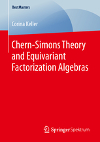- About MAA
- Membership
- MAA Publications
- Periodicals
- Blogs
- MAA Book Series
- MAA Press (an imprint of the AMS)
- MAA Notes
- MAA Reviews
- Mathematical Communication
- Information for Libraries
- Author Resources
- Advertise with MAA
- Meetings
- Competitions
- Programs
- Communities
- MAA Sections
- SIGMAA
- MAA Connect
- Students
- MAA Awards
- Awards Booklets
- Writing Awards
- Teaching Awards
- Service Awards
- Research Awards
- Lecture Awards
- Putnam Competition Individual and Team Winners
- D. E. Shaw Group AMC 8 Awards & Certificates
- Maryam Mirzakhani AMC 10 A Awards & Certificates
- Two Sigma AMC 10 B Awards & Certificates
- Jane Street AMC 12 A Awards & Certificates
- Akamai AMC 12 B Awards & Certificates
- High School Teachers
- News
You are here
Chern-Simons Theory and Equivariant Factorization Algebras

Publisher:
Springer
Publication Date:
2019
Number of Pages:
164
Format:
Paperback
Series:
BestMasters
Price:
69.99
ISBN:
978-3-658-25337-0
Category:
Monograph
[Reviewed by , on ]
Michael Berg
08/4/2019
This book is offered by Springer-Verlag in the BestMasters series, described in the frontispiece as, “Springer awards ‘BestMasters’ to the best master’s theses which have been completed at renowned universities in Germany, Austria, and Switzerland. The studies received highest marks and were recommended for publication by supervisors.” Given the book under review, I can well believe it. Written at U Zurich, Corina Keller’s thesis is a marvel to behold, given what it achieves and how Keller does it.
Chern-Simons theory is, to put it mildly, very hot stuff. In my own experience (leading me to get hold of Keller’s book), it is Chern-Simons-Witten (gauge) theory, situated at the heart of topological quantum field theory (TQFT), that provides the most evocative illustration of what this formalism can do: in the hands of Ed Witten (in the late 1980s) Chern-Simons theory in dimension 2+1 gives us nothing less than (values of) a knot’s Jones polynomial. The best place to learn about this (with relatively little pain, which is of course a misleading promise) is Atiyah’s The Geometry and Physics of Knots. But, beyond knot theory, or even low-dimensional topology, there are plenty of other reasons to favor Chern-Simons theory, given the fecundity of quantum field theory as such: for example, QED (quantum electrodynamics) and QCD (quantum chromodynamics) are special instances of this deep physical theory. And indeed there are many sources to learn this material, split into two equivalence classes: the way the physicists do it vs. the way we do it. A propos, there is a fabulous talk given at UCLA in 2007 by Richard Borcherds, titled, “What is a QFT?”, in which he emphasizes that, as usual, the physicists and we mathematicians do speak very different languages: it is worth looking at Borcherds’ writings on QFT to get the lay of the land (the video is available on iTunes; it’s from the Fields Medalists’ Symposium). In any case, for us mathematicians it’s probably safe to say that the best place to go (if you like marathons with a head wind all the way) is Quantum Fields and Strings: A Course for Mathematicians, edited by Deligne, Etinghof, Freed, Jeffrey, Kazhdan, Morgan, Morrison, and Witten.
But I am getting off track. What about Keller’s book? Well, it has six chapters and the first four do an absolutely fabulous job of presenting the particular differential geometry needed for Chern-Simons theory, a good deal of very important homological algebra, and of course gauge theory. In my experience, in order to get the hang of just how these themes conspire in the context of Chern-Simons theory is rather different a proposition than what one would get by reading, say, Kobayashi-Nomizu and Cartan-Eilenberg --- or more modern standard sources for that matter: one needs a specific direction, consonant with, ultimately, gauge theory. And this is indeed what Keller does. She casts light in some dark and dank corners, so to speak, by highlighting the ways in which various things from, e.g., differential geometry and homological algebra are used in light of Chern-Simons theory. For example, she does a very careful job of treating connections on principal fibre bundles, including the business of their curvature. So, to be sure, this book is very valuable as a guide to the mathematics needed for and going into Chern-Simons theory.
That said, the object of Keller’s thesis is an exposition of factorization algebras, specifically equivariant ones, and she gives the following characterization of what’s going on here: “This construction [of equivariant factorization algebras] allows us to go beyond a purely perturbative viewpoint and to encode topological features of the underlying abelian Lie group in the structure of the classical observables.” And this is a consummation devoutly to be wished: the physicists’ perturbation approaches to QFT lead to divergent series which, in the case of QED, if taken out to only a few terms, give spectacular agreement with experimental results (and this is the stuff renormalization is made of). If this bizarre aspect of perturbation methods could be elucidated by a topological aspect of an abelian Lie group, what a boon that would be.
I think this is a fabulous book, and Keller should be applauded for having written a magnificent master’s thesis.
Michael Berg is Professor of Mathematics at Loyola Marymount University in Los Angeles, CA.
See the publisher's web page.
- Log in to post comments




